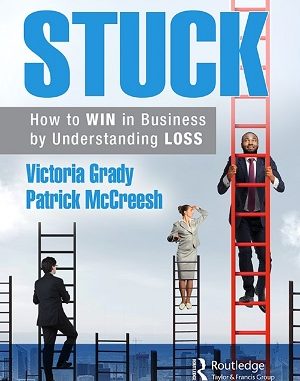
Move on Robert Frost’s Good fences make good neighbors. Good fences make good bosses, and everything that entails. “Leadership is a complex topic. At any given point you can walk down the aisle of your average airport bookstore and find a dozen new products telling you how to ‘lead today’…leadership today is a relationship between the leader, the follower, and the situation. A leader needs to provide all the skills…outline(d)…while aligning the expectations and motivations of the followers in the organization against the situation at hand.
For this process to work, the leader must be able to connect with the follower and create a strong relationship,” Victoria Grady and Patrick McCreesh write in their new book, Stuck: How to WIN at Work by Understanding LOSS. “…(a) leader is more than just a person. The leader is also a representation of the past memory, emotion, and learning that an employee has developed with the organization and likely before the organization. This means that there is great strength in aligning the right leader to the right situation at the right time, but there is also great risk of removing the right leader at the wrong time.”
It’s through sentiments such as these, as well as elaborate meditations on the titular ‘Stuck’ state one can find themselves in via bad communication, where the read really feels like it can click. Sometimes some of what Grady and McCreesh advocate for in terms of leadership advice can feel semi-arbitrary. After all, there is no true owner’s manual to how one on an individualistic scale manages the ins and outs of their enterprise day-in and day-out, minute to minute. However there are increasingly detailed data analyses and reports making strong cases for where things overall and in the long-term should be headed. It’s here that Grady and McCreesh utilize the best of these reports, as well as the tenets making them consistent.
AMAZON: www.amazon.com/Stuck-Victoria-Grady/dp/0367743612
From that, they build their own articulation of respective, brand corporate leadership techniques. “Often in an enterprise transformation there may be a broad-based communications program that will include a variety communications messages, mediums, and messengers. However, these variations may be oversimplified and may not get at the real differences in the organizational populations,” Grady and McCreesh write. “…As a result, the communication techniques and mediums must be varied to meet (different) types. Logistically, this means creating town hall sessions and conference calls to answer in-depth questions for (those who are) Distracted/Stable, but also publishing the same information for the Autonomous/Anxious. It may mean offering coaching packets with detailed information for Direct Supervisors, but also giving supervisors the latitude to hand those materials over to employees who may not engage effectively in those conversations…
One of the keys to successfully moving an organization forward is training. As any new paradigm enters the organization, there is a need to train people on the shift. Whether it is a new strategy, a new process, a new leader, or a new technology; team members need to learn how to succeed in the Future State.” In essence – one word: Communication. Well said.
Clay Burton
